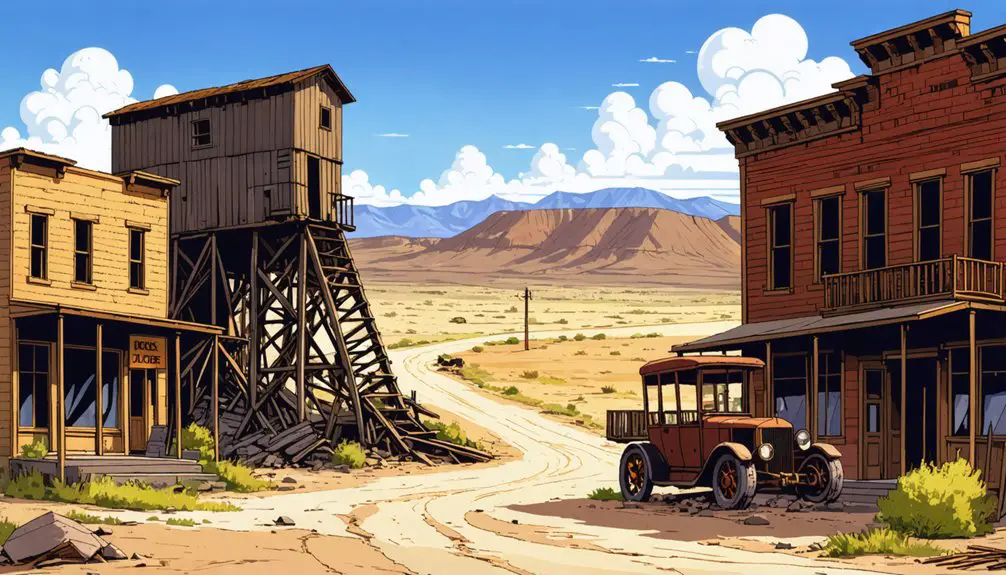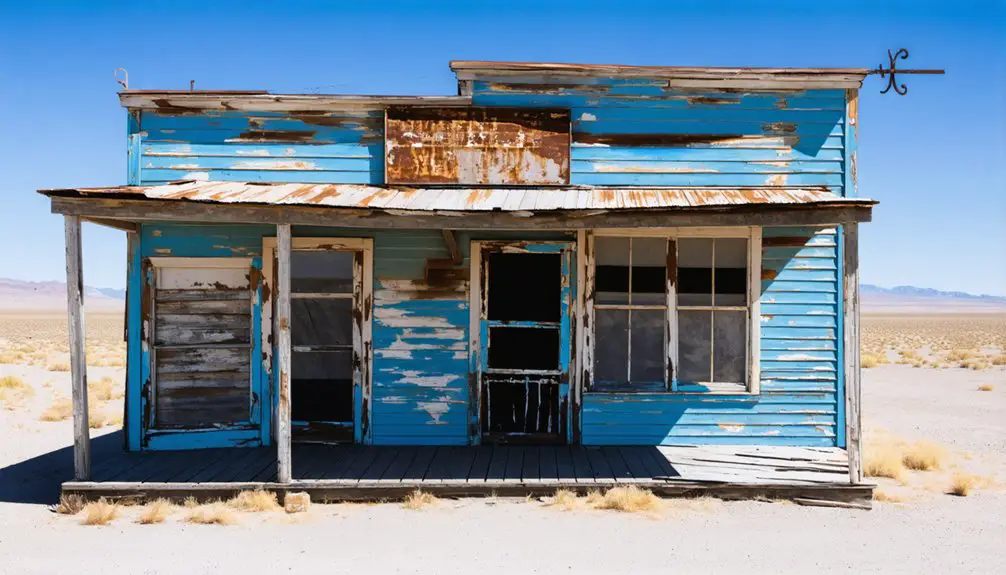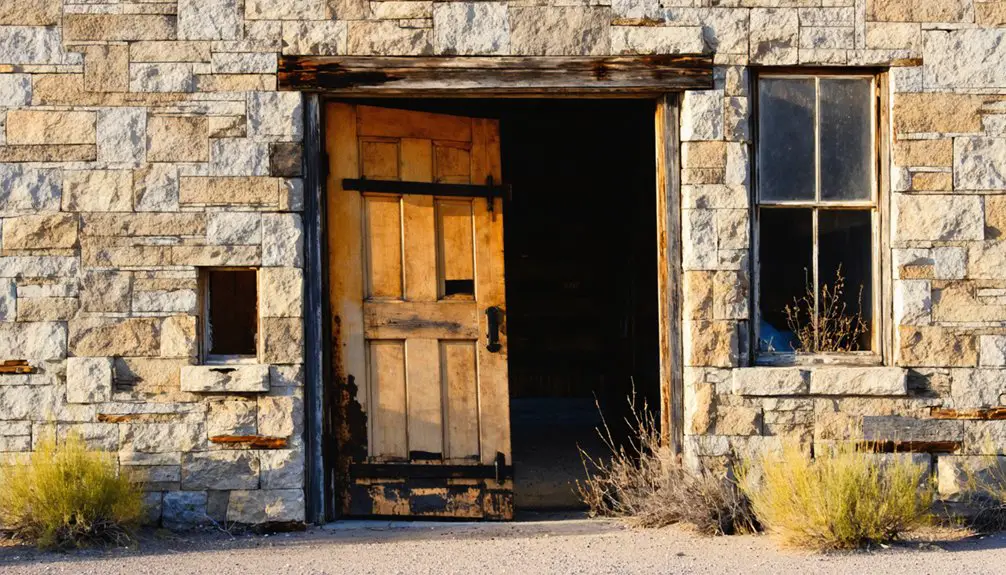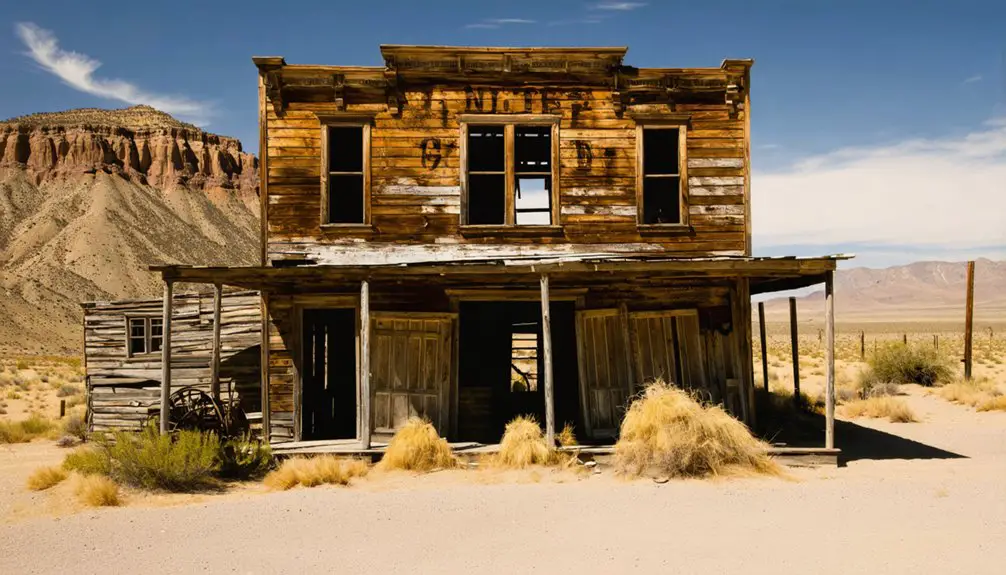You’ll find Ione, Nevada in the Shoshone Mountains, where P.A. Havens discovered silver in 1863, transforming Northern Paiute land into Nye County’s first seat. The town quickly grew to 600 residents with over fifty buildings, including saloons, merchants, and a courthouse. While silver price crashes triggered population decline, Ione never completely died – around 40 residents still call it home today. The town’s preserved structures and remarkable survival story reveal fascinating layers of Western history.
Key Takeaways
- Established in 1863 after silver discovery, Ione became Nye County’s first county seat with over 600 residents.
- Despite multiple mining booms and busts, Ione never became completely abandoned and maintains about 40 residents today.
- Historic buildings remain, including the Ore House Saloon and original stone structures from the 1860s mining era.
- The town experienced severe population decline after 1867 when residents left for more prosperous Belmont.
- Known as “the town that refused to die,” Ione’s isolation helped preserve its historic structures for ghost town tourism.
The Silver Discovery That Started It All
When P.A. Havens discovered silver in Union Canyon in 1863, he sparked a pivotal moment in Nevada’s mining history. The discovery quickly attracted over 600 workers who brought their mining techniques to the Shoshone Mountains, establishing what would become Ione City in 1863-1864.
The 1863 silver discovery in Union Canyon transformed Nevada’s landscape, drawing hundreds of miners to establish Ione City.
The settlement’s community resilience was evident from the start as it transformed from untamed wilderness into a prosperous mining center. Initially, the town served as a trade and milling center rather than focusing on mining operations. The area had been home to Northern Paiute tribes for thousands of years before the silver discovery.
You’ll find that Ione’s significance grew rapidly, leading to its designation as Nye County’s first county seat in 1864. The rich silver deposits turned this remote location into a bustling hub of activity, with infrastructure and businesses springing up to support the growing population.
The town’s establishment marked the beginning of organized settlement in this part of Nevada’s rugged terrain.
Life in Early Ione During the 1860s Boom
You’d find a rapidly growing silver rush community in Ione during 1864, as the population swelled beyond 600 residents and over fifty buildings sprang up within months of the town’s establishment.
The bustling town center featured essential pioneer businesses including saloons, newspapers, a post office, and various merchants catering to miners’ needs, while the construction of a courthouse cemented Ione’s status as the newly formed Nye County seat. The first county courthouse was built using an $800 grant.
Local milling operations processed silver ore from nearby mines, creating a self-sufficient economic hub that drew more settlers to the area throughout the mid-1860s boom period. Unfortunately, the town’s prosperity was short-lived when many residents departed for more prosperous Belmont in 1867.
Daily Mining Town Life
During the 1860s silver boom, life in Ione centered around the demanding rhythms of mining operations, with most residents working long hours at nearby silver mines while living in primitive conditions.
You’d find miners employing basic mining techniques in the surrounding hills, returning to makeshift shelters, tents, or caves after their shifts. The town’s development followed the typical pattern of frontier settlements, with essential services emerging to support the growing population. The bustling town soon boasted two newspapers to keep residents informed. With the town serving as the Nye County seat in 1864, government activities brought additional vibrancy to daily life.
- Your daily routine would revolve around the mines’ schedule, with work starting at dawn.
- You’d rely on local stores, saloons, and the stagecoach line for supplies and connection to the outside world.
- Community events would often take place at the saloons, serving as social hubs.
- You’d face constant uncertainty as silver prices determined the town’s prosperity or decline.
Silver Rush Community Growth
The discovery of silver by P.A. Havens in 1863 transformed Ione from empty desert into a bustling frontier settlement.
Within months, you’d have witnessed the rapid construction of over 100 buildings as the population swelled to 600 residents, reshaping the community dynamics of this emerging boomtown.
The town received $800 in funding for the construction of a modest wooden courthouse.
The town’s growth and significance led to Ione being designated as the first county seat of Nye County in 1864.
Pioneer Business Development
As silver discoveries transformed Ione’s landscape in 1863, pioneer businesses rapidly emerged to serve the bustling population of 600 residents.
Pioneer entrepreneurship flourished with the establishment of general stores, restaurants, saloons, and essential services. The town’s mining technology advanced through operations like the 5-stamp Pioneer Mill and the larger Knickerbocker Mill, which processed ore from surrounding mines. The mill achieved significant progress when it shipped 166 pounds of bullion in July 1866. Like the thriving Paul’s Pioneer Mill in Silver City, these operations were vital to the region’s development.
You’d find stagecoach lines connecting the town, while newspapers like the Nye County News kept residents informed. The 1864 designation as county seat brought government infrastructure and a courthouse, further stabilizing commerce.
- Mining enterprises struggled with ore quality, leading to Pioneer Mill’s closure after just one year.
- The $130,000 Knickerbocker Mill investment showed eastern capital’s confidence in Ione.
- Local businesses adapted to serve both miners and government officials.
- Transportation and communication services proved crucial for early business success.
Rise and Fall as Nye County’s First Seat
Following silver discoveries by P.A. Havens in Union Canyon, Ione emerged in 1863 and quickly became the first seat of the newly formed Nye County in 1864.
You’ll find that Ione’s legacy as a center of county governance began when officials allocated $800 for a wooden courthouse, establishing formal administrative functions. The town flourished initially, boasting over 100 buildings and 600 residents by spring 1864.
However, you can trace Ione’s decline to dwindling ore yields and competition from Belmont’s richer strikes.
Mining Challenges and Economic Cycles

Despite early optimism around Union Canyon’s silver discoveries in 1863, you’ll find that Ione’s mining operations struggled with inadequate ore processing facilities and low yields.
The construction of a 10-stamp mill in 1896 sparked brief prosperity, but the silver price crash of 1898 quickly ended that boom.
Throughout Ione’s history, you can trace how volatile silver market prices repeatedly undermined mining ventures’ long-term viability, leading to cycles of brief prosperity followed by economic decline.
Ore Processing Setbacks
While the construction of a 10-stamp mill in the 1890s initially boosted Ione’s silver mining prospects, the town soon faced persistent challenges in ore processing that would ultimately contribute to its decline.
The mining infrastructure struggled with inconsistent ore quality and toxic mercury-bearing cinnabar, making processing both difficult and hazardous. You’ll find that equipment maintenance costs and necessary technological upgrades strained operations, especially during market downturns.
When combined with fierce competition from nearby Belmont’s superior deposits, these factors severely limited Ione’s ability to sustain profitable mining operations.
- The variability in ore grade and composition complicated processing methods
- Toxic mercury content posed serious health risks and restricted processing options
- Heavy capital investments became risky during production volatility
- Mill operations suffered from fluctuating ore volumes and quality issues
Silver Market Price Swings
The dramatic swings in silver prices throughout the late 1800s repeatedly destabilized Ione’s mining operations and local economy.
You’ll find that when silver prices dropped, mining operations quickly became unprofitable, forcing closures and triggering population exodus. The most notable crash came in 1897, devastating the town’s milling operations.
These silver price fluctuations created a brutal cycle of boom and bust that derailed mining investment impacts.
When prices rose, you’d see new infrastructure like the 5-stamp Pioneer Mill in 1865 and a 10-stamp mill in the 1890s. But these investments failed within months when prices plummeted.
The instability drove miners and capital to richer strikes like Belmont, slashing Ione’s population from 600 to under 200 by 1868 and eventually cost the town its county seat status.
The Town’s Remarkable Survival Story
Since its establishment in 1863, Ione has demonstrated remarkable resilience by maintaining continuous habitation through multiple boom-and-bust cycles.
You’ll find a reflection of community resilience in how the town adapted from a bustling mining center to a quiet residential ghost town. Despite losing its county seat status in 1868 and experiencing the closure of its post office in 1959, Ione’s cultural heritage lives on through its preserved historic buildings and determined residents.
- The town’s population has never dropped to zero, maintaining around 40 residents today
- Locals proudly call it “the town that refused to die”
- Its isolation has paradoxically helped preserve both its structures and community
- Historic buildings now serve as living museums, attracting ghost town tourism
Historic Buildings and Landmarks Today

Standing as silent witnesses to Ione’s mining legacy, numerous historic buildings and landmarks dot this remote Nevada ghost town’s landscape.
You’ll find the iconic Ore House Saloon building, weathered stone structures, and remnants of commercial buildings that showcase the town’s architectural significance from the 1860s onward. The original county seat marker reminds you of Ione’s role as Nye County’s first administrative center in 1864.
Despite minimal historic preservation efforts, you can explore abandoned mining equipment, original post office ruins, and historic cemeteries that paint a picture of frontier life.
The town’s authentic character remains intact, with simple utilitarian designs and native stone construction reflecting the era’s craftsmanship. While most structures show advanced decay, a handful of residents maintain continuous habitation since 1863, keeping Ione’s spirit alive.
Natural Wonders Around Ione
Beyond Ione’s historic structures lies a remarkable landscape shaped by ancient volcanic forces.
You’ll discover the Lunar Crater’s obsidian-laden lava beds and Timber Mountain Caldera, showcasing Nevada’s volcanic past. The region’s wildlife habitats include Ruby Marsh, spanning 40,000 acres and fed by 200 natural springs.
At Angel Lake, situated at 8,400 feet, you can explore alpine environments against the backdrop of the East Humboldt Mountains.
- Diana’s Punch Bowl’s scalding travertine hot spring demonstrates the area’s active geothermal features
- Sand Mountain’s “singing” dunes echo with mysterious sounds from an ancient lakebed
- Volcanic landscapes have created perfect conditions for garnets and black fire opals
- Ruby Marsh stands as one of America’s most isolated wildlife refuges, protecting diverse bird species
Planning Your Visit to Nevada’s Living Ghost Town

Nestled along Nevada’s “Loneliest Road in America,” Ione beckons visitors to experience an authentic ghost town that refuses to fade into history.
To make the most of your ghost town exploration, plan your trip from Middlegate, about an hour’s detour off Highway 50. You’ll need to pack essential supplies, as there aren’t any commercial services in Ione.
For historical photography enthusiasts, the town’s preserved structures offer compelling subjects, from vintage homes to the iconic Ore House Saloon.
Consider combining your visit with Berlin-Ichthyosaur State Park, just a few miles south, to maximize your adventure. The town’s small population of year-round residents maintains the ghost town’s authentic atmosphere while keeping it alive.
Time your visit during daylight hours and bring appropriate gear for self-guided tours through this remote piece of Nevada’s mining heritage.
From Native American Land to Mining Settlement
Long before prospectors discovered silver in Ione Valley, Northern Paiute and Western Shoshone peoples had called this region home for millennia, leaving behind petroglyphs dating back 14,800 years.
Ancient petroglyphs stand testament to Northern Paiute and Western Shoshone peoples who thrived in Ione Valley millennia before silver’s discovery.
This Native heritage included sophisticated hunter-gatherer societies and early agricultural practices, with established seasonal routes and trade networks across Nevada’s challenging terrain.
The discovery of silver in 1863 dramatically transformed the valley, as miners flooded the area, displacing indigenous communities from their ancestral lands through forced removals and broken treaties.
- The land’s Cultural significance spans over 5,000 years of continuous Native habitation
- Traditional indigenous life remained largely undisturbed until the 1860s mining boom
- Within one year, over 600 miners replaced Native communities in the valley
- Many displaced tribes struggled for federal recognition well into the 20th century
Frequently Asked Questions
What Happened to the Original Mining Equipment and Machinery in Ione?
You’ll find that mining relics were salvaged, scrapped, or relocated after operations ended, with abandoned machinery gradually dismantled – especially after 1932, when the mercury mill was torn down by 1950.
Are There Any Documented Paranormal Activities or Ghost Stories From Ione?
While whispers of ghost sightings float through the old Ione Hotel, you’ll find that documented paranormal claims are surprisingly sparse. Local legends exist, but they’re mainly unverified stories passed down through generations.
How Do Current Residents Get Their Basic Supplies and Utilities?
You’ll need to be self-reliant since there’s no grocery delivery or utility services. You must drive weekly to nearby towns for supplies and maintain your own power, water, and other necessities independently.
What Was the Highest Recorded Silver Production Value in Ione’s History?
While silver mining held historical significance, you won’t find exact production values recorded. The peak likely occurred during 1863-1867’s initial boom, with a secondary surge in 1897 before collapsing.
Can Visitors Stay Overnight in Any of the Historic Buildings?
You can’t stay overnight in Ione’s historic buildings. There aren’t any accommodations available due to historic preservation concerns and lack of services. You’ll need to find lodging in nearby towns instead.
References
- https://www.sfgate.com/travel/article/nevada-ghost-town-with-two-remaining-residents-19821636.php
- https://www.youtube.com/watch?v=bXV3g1s3Jgk
- https://www.youtube.com/watch?v=SBHRlgmCeoM
- https://shpo.nv.gov/nevadas-historical-markers/historical-markers/ione
- https://travelnevada.com/ghost-town/ione/
- http://www.nv-landmarks.com/ny/shl159.htm
- https://coloradosghosttowns.com/Ione NV.html
- http://www.onv-dev.duffion.com/articles/ione
- https://www.nvexpeditions.com/nye/ione.php
- https://www.youtube.com/watch?v=W3HExk6cFzE



